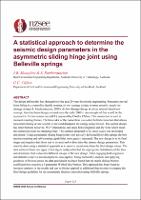| dc.contributor.author | Mountfort, Jason | |
| dc.contributor.author | Ramhormozian, Shahab | |
| dc.contributor.author | Clifton, G. Charles | |
| dc.date.accessioned | 2020-06-18T13:53:57Z | |
| dc.date.available | 2020-06-18T13:53:57Z | |
| dc.date.issued | 2020-04-22 | |
| dc.identifier.uri | https://repo.nzsee.org.nz/xmlui/handle/nzsee/1734 | |
| dc.description.abstract | The design philosophy has changed over the past 20 years in seismic engineering. Structures moved from failing in a controlled ductile manner, to low damage design, to more recently, nearly no damage design (S. Ramhormozian, 2018). As low damage design is not an entirely brand-new concept, there has been designs around since the early 2000’s. An example of this would be the asymmetric friction connection (AFC) proposed by Charles Clifton. This connection is used in moment resisting frames. The basic idea of the connection is a slotted bolted connection that allows movement during severe seismic events and dissipates the energy using friction. The current design has imperfections however, MVP interactions can cause bolt elongation and ply wear which mean the connection loses its clamping force. The solution proposed to fix these issues was developed and tested. Using asymmetric sliding hinge joints with partially deflected Belleville springs the bolt tension retaining and self-centring capabilities were greatly increased. The new design is in its final stages and requires data from test to be analysed to determine the seismic design parameters. This must be done using a statistical approach as to remove uncertainty from the final design values. The data achieved from two types of test rigs is analysed to find the appropriate distribution of the data and determine final values for different set-ups of the new design. After engaging both engineers and statistics expert a statistical process was applied. Using probability analysis and applying goodness of fit tests across the data provided it has been found that the stable sliding friction coefficient best matches a 3-parameter Weibull distribution. This approach has been found to increase certainty in the results and can be further applied to additional data in order to prepare the final design guideline for the asymmetric friction connection using Bellville springs. | |
| dc.language.iso | en | |
| dc.publisher | New Zealand Society for Earthquake Engineering | |
| dc.relation.ispartofseries | 2020;123 | |
| dc.subject | Design for control of seismic damage | |
| dc.title | A statistical approach to determine the seismic design parameters in the asymmetric sliding hinge joint using Belleville Springs | |
| dc.type | Article | |

